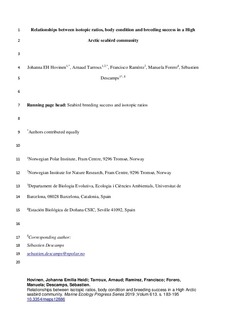Relationships between isotopic ratios, body condition and breeding success in a High Arctic seabird community
Hovinen, Johanna Emilia Heidi; Tarroux, Arnaud; Ramirez, Francisco; Forero, Manuela; Descamps, Sébastien
Peer reviewed, Journal article
Accepted version

View/
Date
2019Metadata
Show full item recordCollections
- Scientific publications [1392]
Original version
10.3354/meps12886Abstract
Predators such as seabirds are often used as bio-indicators of the marine environment. This is based on the assumption that changes in seabird populations are driven by changes in their prey. We tested this assumption in a High Arctic seabird community by assessing the relationships between the diet, body condition, and breeding performance of 4 ecologically different species: the little auk Alle alle, black-legged kittiwake Rissa tridactyla, Brünnich’s guillemot Uria lomvia, and glaucous gull Larus hyperboreus, breeding in Svalbard, Norway. Interannual changes in seabird diet (2009−2015) were assessed by estimating their carbon and nitrogen isotopic ratios (δ15N and δ13C) during the breeding and non-breeding seasons (i.e. using blood and feather tissues). We found interannual variation in the isotopic ratios during both seasons in all 4 species. These variations differed among species, thus suggesting dietary changes, instead of changes in isotopic baselines, as the most plausible mechanism underlying such patterns. We also found that seabirds had a lower average hatching success when the average δ15N during the previous nonbreeding season was higher. Our results suggest that changes in the average prey composition during the non-breeding season may partially explain changes in breeding performance of Svalbard seabirds.